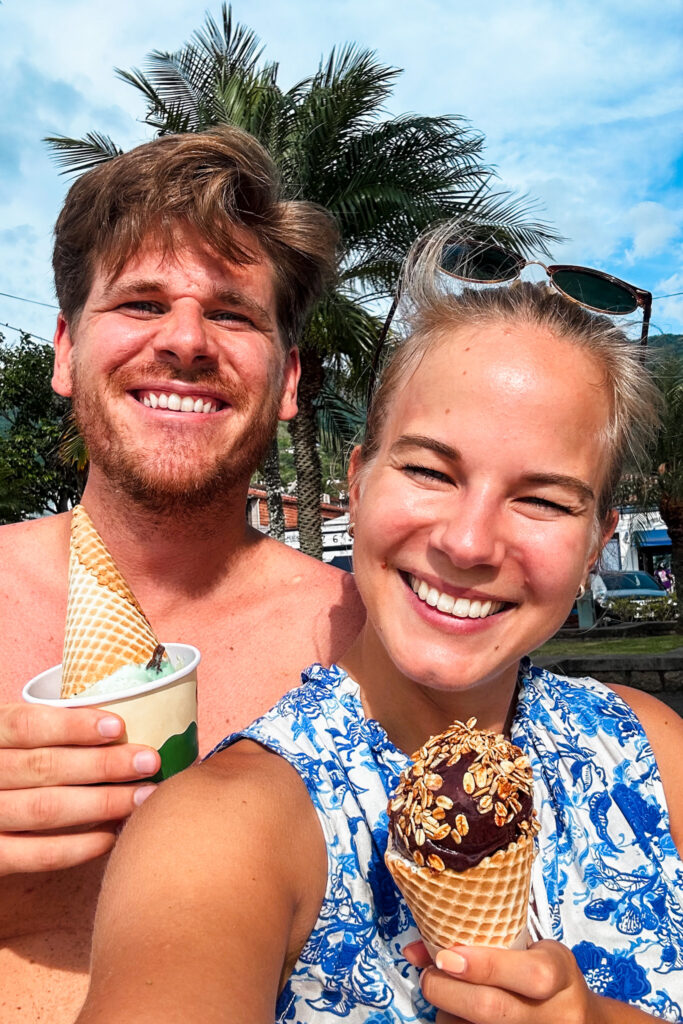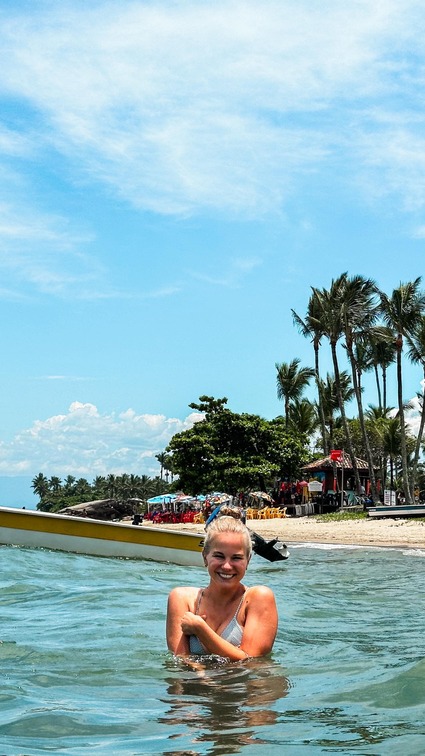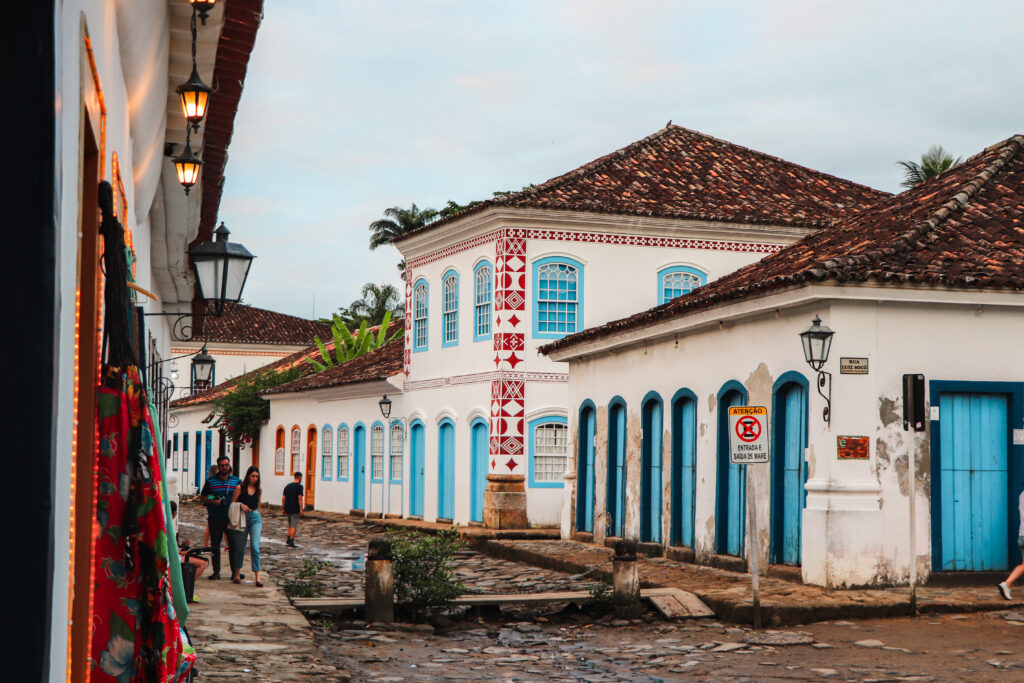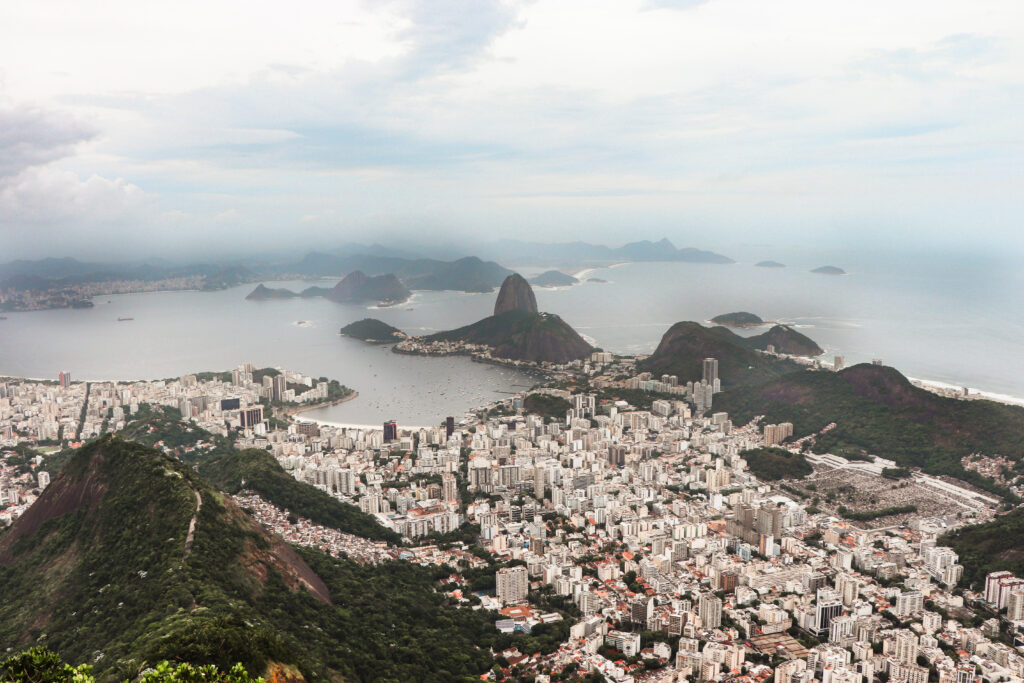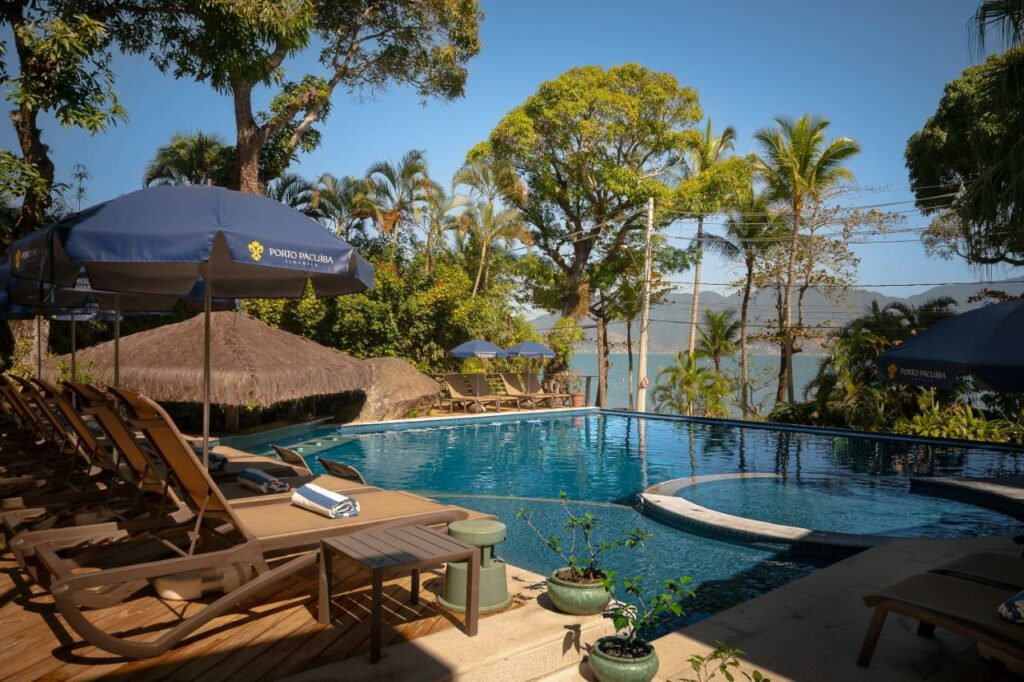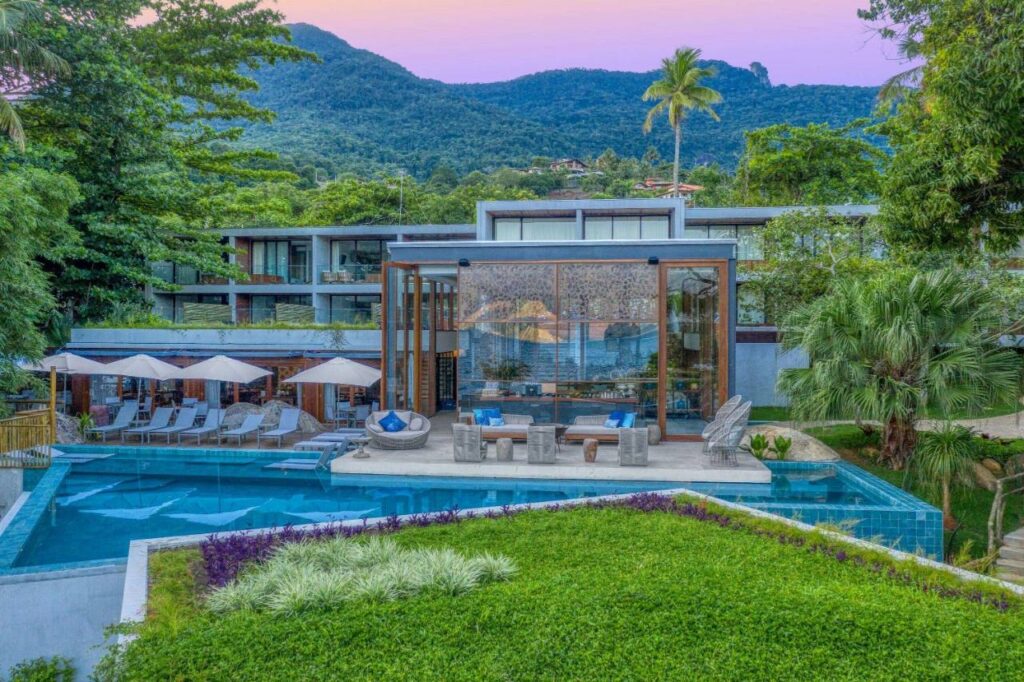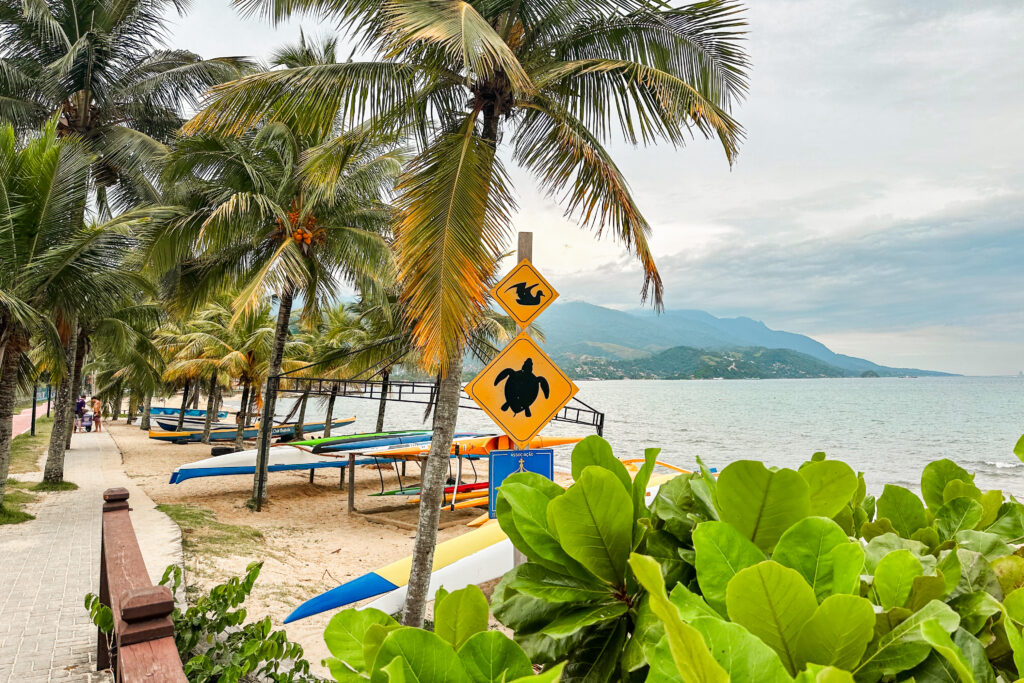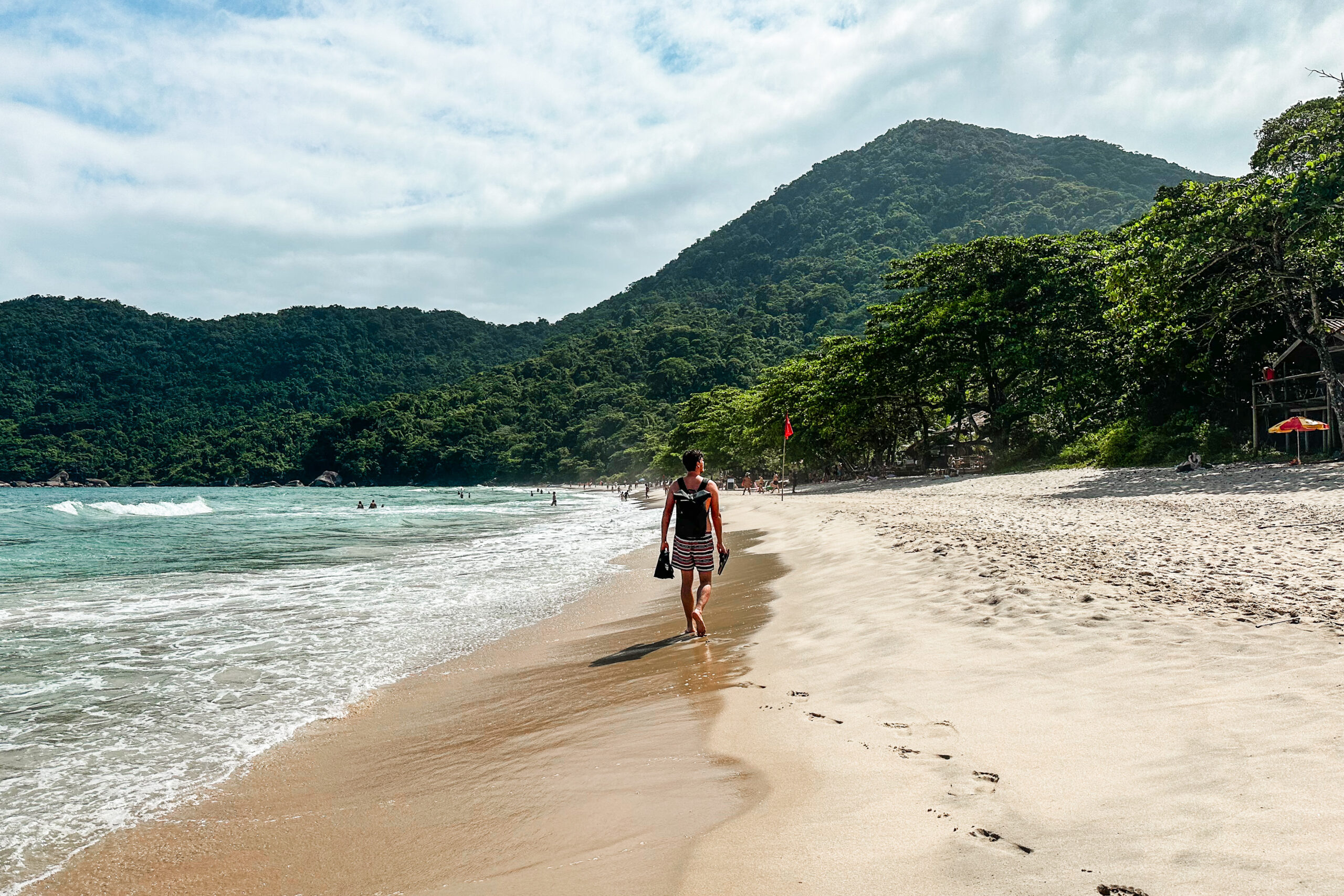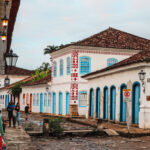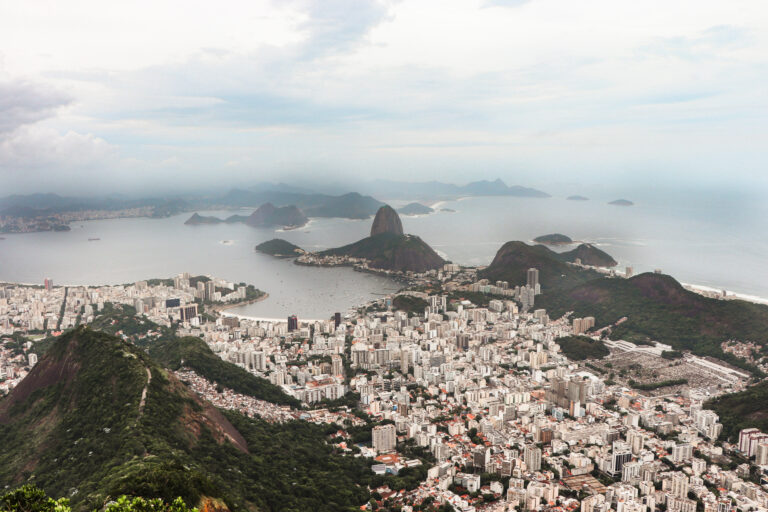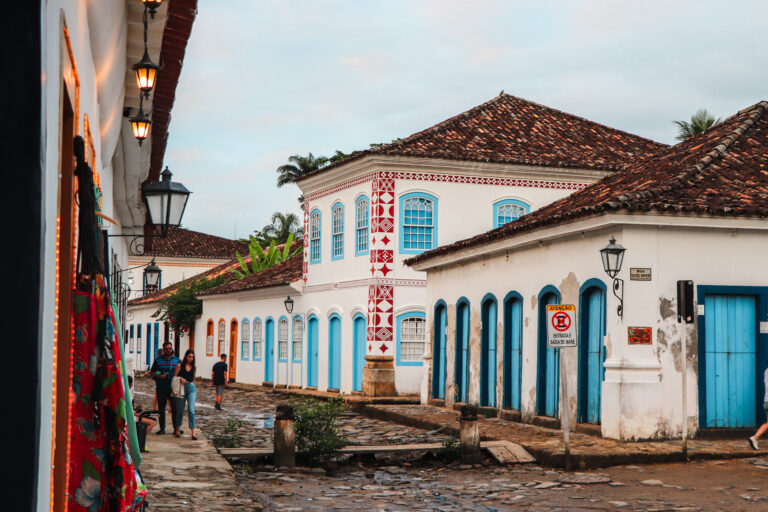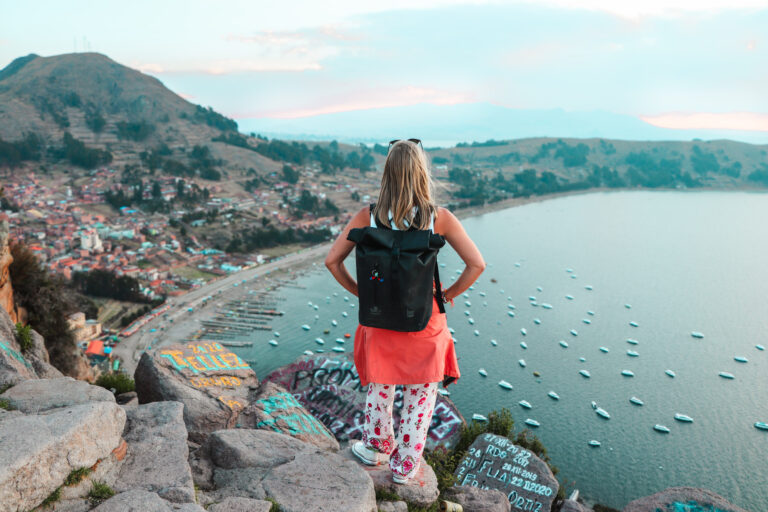Ilhabela is one of Brazil’s most beautiful islands – literally. We escaped the beaten paths to spend a week in paradise, and to find out if Ilhabela lives up to its name.
In this comprehensive Ilhabela travel guide, we’ll tell you everything you need to know to enjoy your trip to Ilhabela to the fullest. Read about all of the things to do, where to go and stay, and when it’s the best time to experience Brazilian island life.

9 Laid-Back Things to Do in Ilhabela, Brazil
Ilhabela has stunning mountain views, hundreds of waterfalls, amazing beaches, and jungle trails – all of them waiting to be discovered. It’s one of the most sought-after destinations for Brazilians for a reason. We’ll show you all of the laid-back things to do on this otherworldly paradisical island. But the most important thing to do we tell you right away: Take time off to relax and recharge, escape the rush of daily life, and enjoy your days in paradise.
Now that we have that out of the way, let’s talk about all of the other laid-back activities that will await you on Ilhabela.
1. Visit Ilhabela’s most beautiful beaches
With over 40 beaches, Ilhabela is a beach haven. For us, the beaches on this island were some of the most beautiful we had been to during our whole backpacking trip through South America. You’ll find them scattered all over the island, but the most accessible ones are near the villages on the West Coast. Here, you also find lovely accommodations in walking distance to the beaches.
So, let’s go through the best beaches in Ilhabela.
Praia do Perequé
Praia do Perequé is one of the beaches where we spent most of our time. It’s surrounded by large palm and coconut trees and is simply idyllic. You’ll also find plenty of nice beachfront bars and restaurants nearby.
It’s a great place to hang out, enjoy the day, rent a jet ski, SUP, or kayak, and enjoy a sunny day in Ilhabela. It’s a popular and sometimes busy beach, but that was also what we loved the most. Expect beach vibes, good music, and friendly locals here.

Praia do Itaguaçu
Praia do Itaguaçu is right next to Praia do Perequé. Being more chilled, it’s a perfect place to calm down and unwind. Praia do Itaguacu was the beach closest to our accommodation, and we mostly went there to nap and relax. And sometimes we even saw turtles swimming around when we dipped in the ocean.
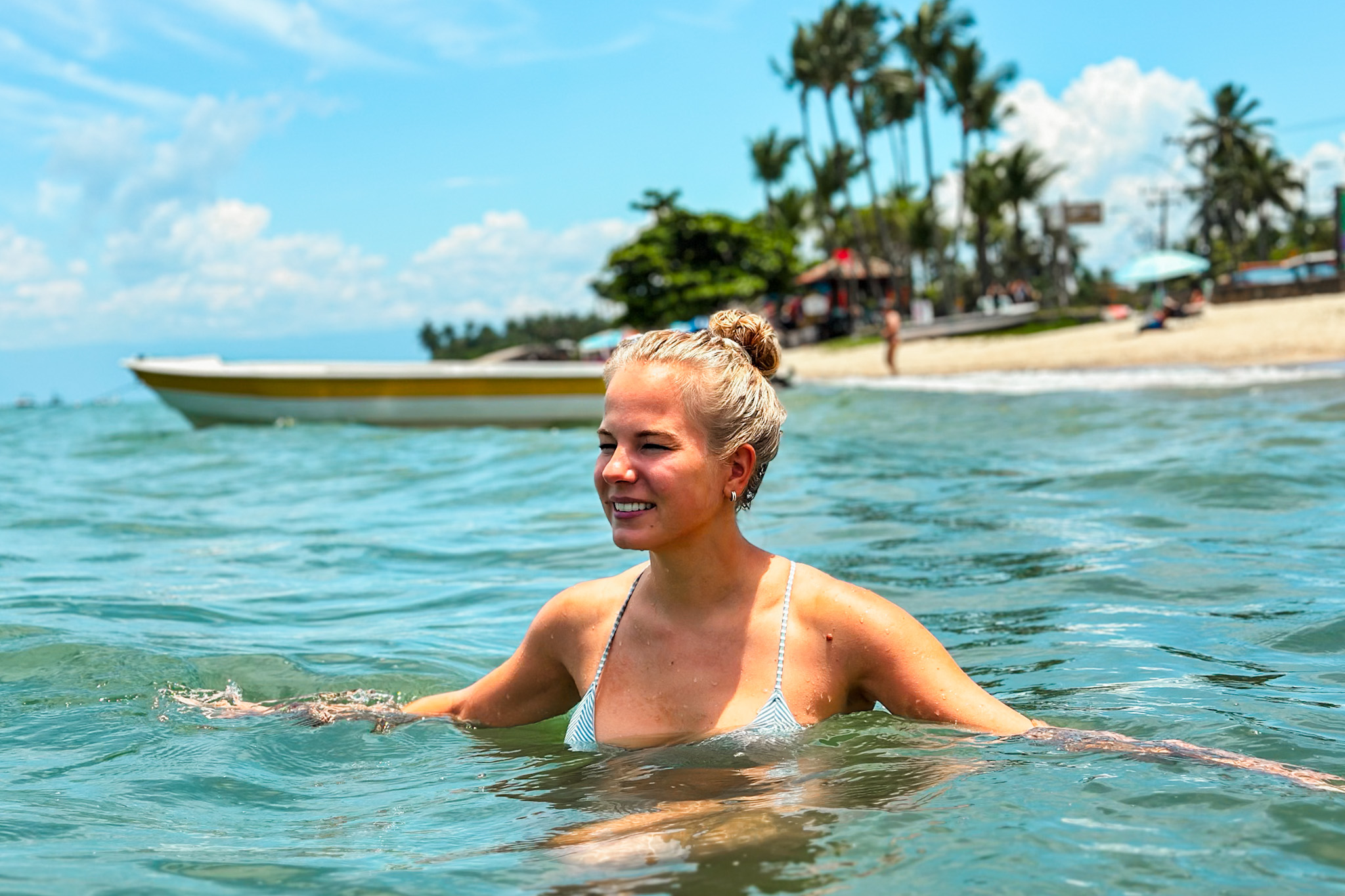
Praia do Itanquanduba
A little further North, but still in walking distance to the Praia do Itaguaçu and Praia do Perequé, is the Praia do Itanquanduba. It’s quite long and therefore also quieter.
You’ll have shallow waves, nice sunsets, and some trees to find shade. Parking spots here are limited, so it’s best to park your car near Praia do Itaguacu.
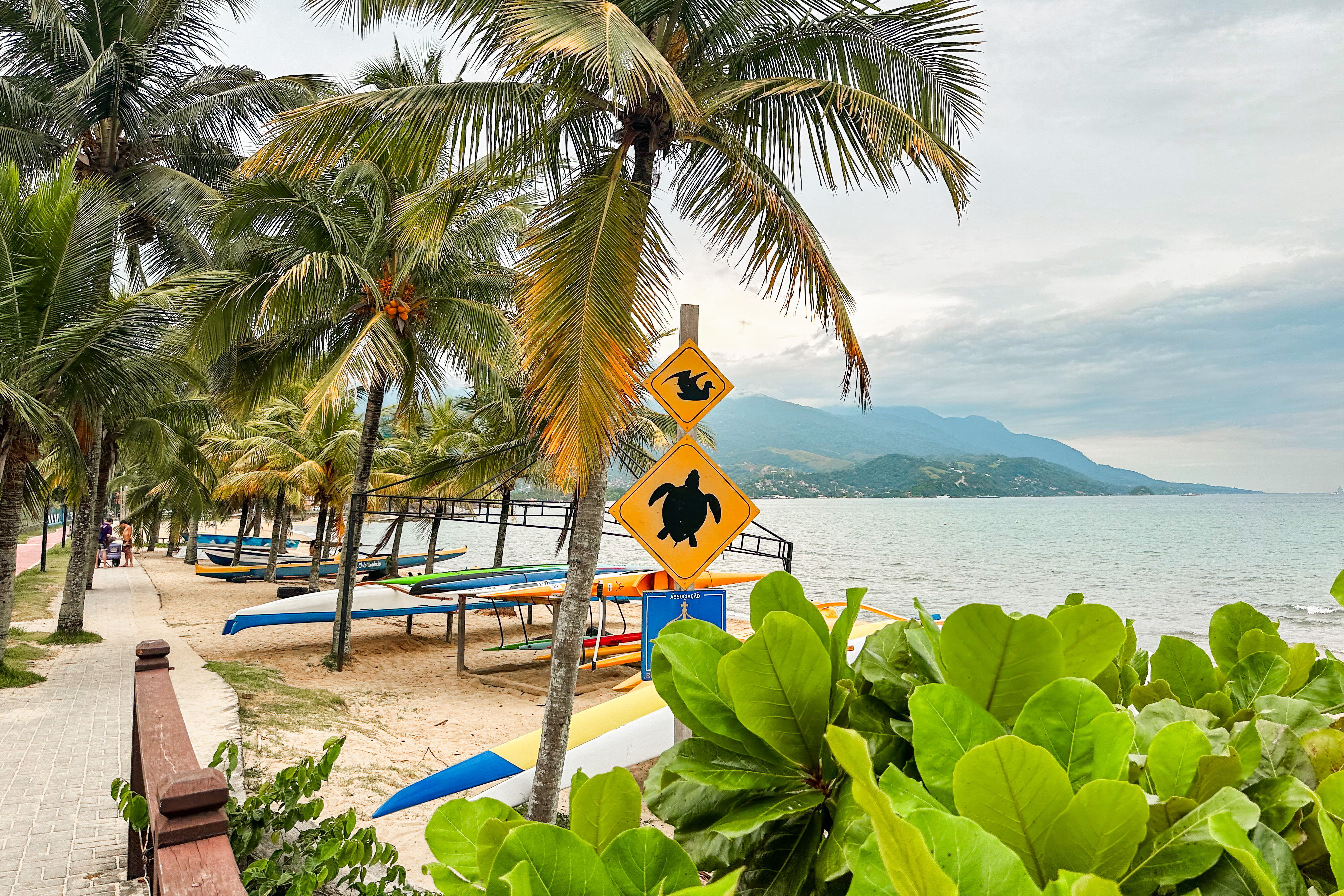
Praia Grande
Praia Grande is, as the name suggests, one of the biggest beaches of Ilhabela. It’s a wonderful place to take a rest, walk the pier for a different view, and check out the bars and restaurants around. You’ll find Praia Grande next to Praia do Julião, so if you don’t stay there, check out both on your beach trip.
Praia do Julião
Praia do Julião is one of the more secluded beaches in Ilhabela. What makes this beach special among the others are the big rocks at its sides. There you’ll find crystal-clear water, white sand, and shade under the palm trees.
Make sure to visit this place on a weekday, as it tends to get a little crowded during weekends. Praia do Julião is also connected to Praia Grande with a little trail, so visiting both beaches as part of a day trip is a good idea.
Praia Curral
Praia Curral is a little farther from the city, south of Praia Grande and do Julião. It’s one of the busiest beaches. You’ll get the typical beach vibes, music, events, bars, and kiosks. It’s easily reachable by bus, and we’d say it’s more a place for larger groups and people who like to party.
Praia do Castelhanos
Praia do Castelhanos is a remote beach on the East Coast of Ilhabela and is known for its panoramic views. Because it’s so remote, you can only access it by boat, 4×4, motorcycle, bicycle, or on foot.
Most people visit this place as part of a tour that leads 15 km (9 miles) through the Ilhabela State Park. Once there, you can enjoy a 2 km (1 miles) long sandy beach that is among the most beautiful in Brazil or hike to the famous island viewpoint.
Praia do Bonete
Considered to be the most famous beach on the island and featured multiple times as one of the top 10 beaches in Brazil, Praia do Bonete is a very secluded and remote beach on the southern part of Ilhabela. It’s best to hop on a 40-minute boat ride from Praia Perequé to get there. While there’s also the option to hike for about 4 hours and 12 km (7 miles) through the jungle, this option is definitely only for the adventurous of us.
We haven’t visited Praia do Bonete, because we felt like the pictures weren’t as mind-blowing as advertised, and because we were already super happy about the beaches on the west side of the Island.
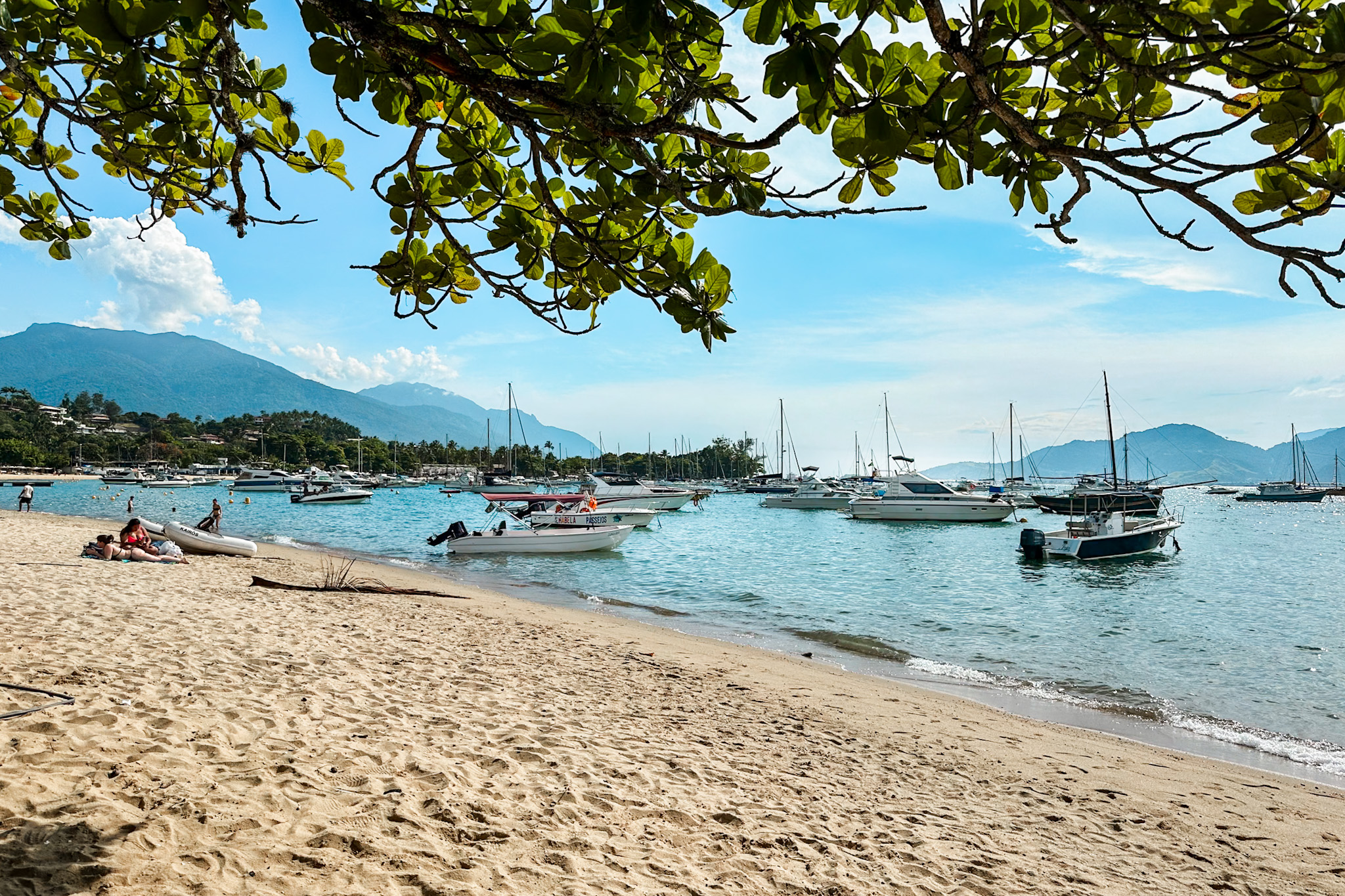
2. Discover the coolest waterfalls on the island
Ilhabela awaits you with waterfalls to fall in love with. Some say there are over 360. While we haven’t had the chance to visit all of the beautiful waterfalls (with around 360 waterfalls, it would mean going to a different one every day a year), we picked you the ones we enjoyed the most during our stay in Ilhabela. Hiking to a waterfall is a cool adventure if you are getting tired of going to beach every day.
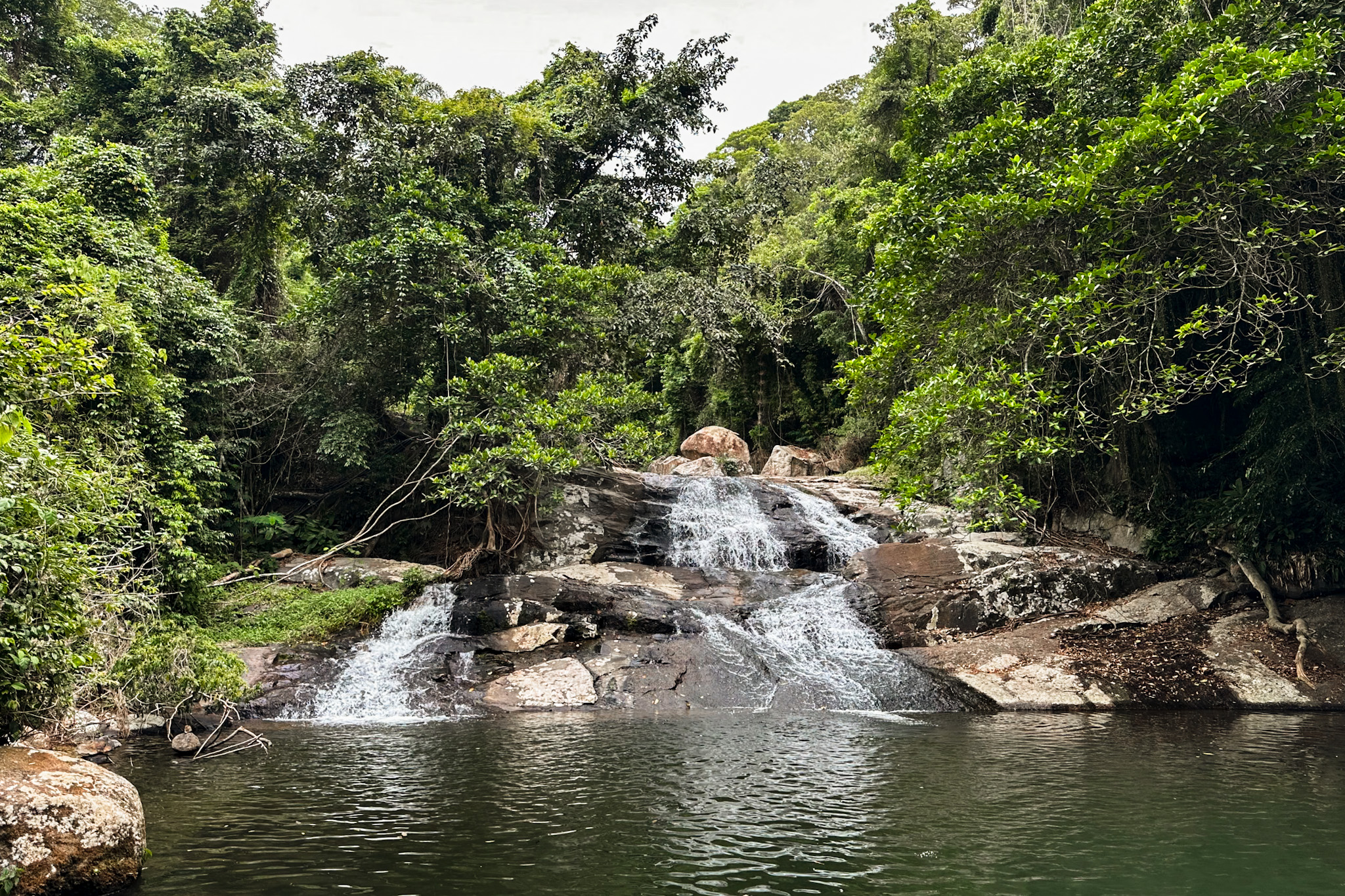
Cachoeira do Paquetá
Cachoeira do Paquetá was our favorite waterfall on Ilhabela, because of many reasons. Firstly, you’ll get to see three waterfalls for the price of hiking to one. Secondly, all of them are beautiful. If we hadn’t read that there were two more falls to see, we would have spent all of our time in the natural pools at the first level. And thirdly, if you make it to the third drop, you can enjoy panoramic views from a natural infinity pool and ride a natural slide, which seems scary at first but is super fun. Try it!
The waterfall is secluded, in the midst of nature, and requires a bit of hiking, so only very few tourists found their way to this wonderful place. To get there, take the bus to the station nearest to the waterfall. When you arrive at the end of the street, you’ll see a sign marking the trailhead to the waterfall (a 20-minute walk from the station). The trail to the Cachoeira do Paquetá leads through the jungle. Yellow markings are hanging from the trees to show you the way. Make sure to wear proper hiking shoes and don’t forget to bring plenty of bug spray – those black flies are nasty here. Cachoeira do Paquetá is free to visit.


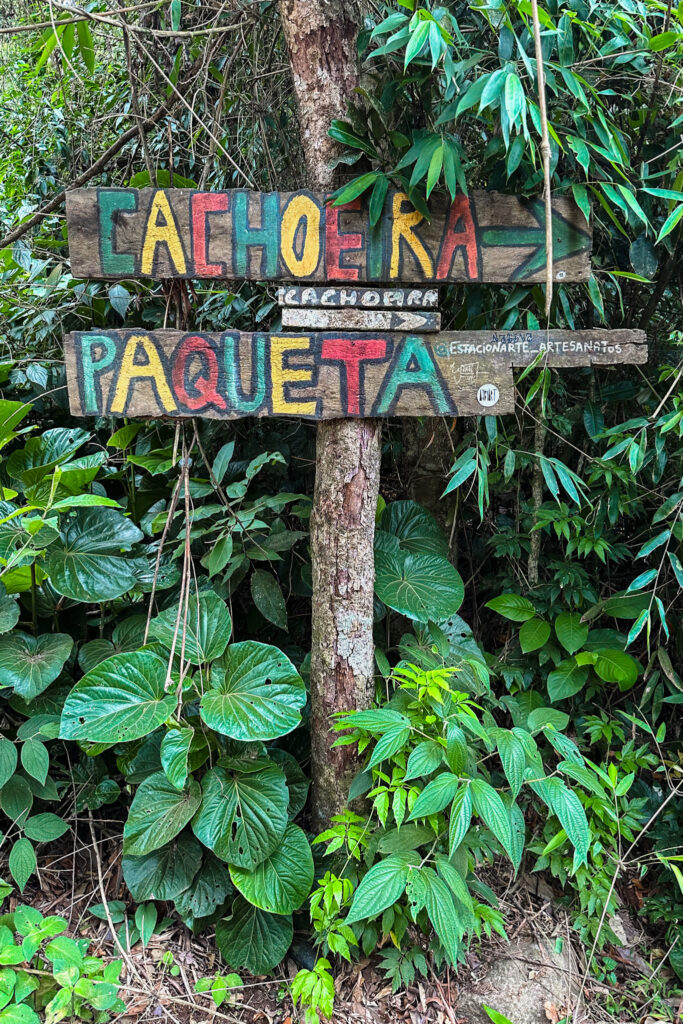
Cachoeira do Gato
With over 50 meters (164 feet), Cachoeira do Gato (Cat’s Waterfall) is the tallest waterfall in Ilhabela. It’s secluded in the jungle and not easily accessible, but you can combine your visit with a 4×4 or speedboat trip to the remote Praia de Castalhanos.
From the beach, it’s a 2 km (1 miles) or around a 30-minute walk to the waterfall. The trail is marked, so you don’t need to be local to find it. Wear proper shoes (slippery trail), bring a bottle of water (very humid), and apply plenty of bug spray (blackflies) to have an enjoyable hike to Cachoeira do Gato.
Cachoeira da Toca
Cachoeira da Toca is one of the more accessible waterfalls. It is close to Ilhabela town and easily reachable by car or on foot. Cachoeira da Toca has three natural pools for you to dip into. The trail to the waterfall is paved and well-marked. There are parking places and even a kiosk on site.
Because this place is privately owned, accessing the waterfall comes with an entrance fee of 50 BRL (≈ 10 USD). The owners are friendly and, if you have some time to spare, try their artisanal Cachaca which they locally produce using their own mill.

3. Explore Ilhabela’s old town in Vila
Strolling through Ilhabela’s old town Vila is one of the must-things to do when on the island. This beautiful little village welcomes you with charming colonial buildings, nice restaurants, boutique shops, and a feeling that sets you back in time.
Start by walking along the Rua do Meio to explore Vila’s center. Then head to the Igreja de Nossa Senhora, the village’s church and one of the oldest buildings in Ilhabela. Next to the church, you find the Ilhabela Nautica Museum, where you can learn about the region’s maritime history. You may want to pass by the nearby Praça Centro Ilhabela square, where people jump over the water fountains, and end your trip by walking along the coast to Vila’s pier. If you’re lucky, you’ll see one of the transatlantic cruise ships leaving the port.
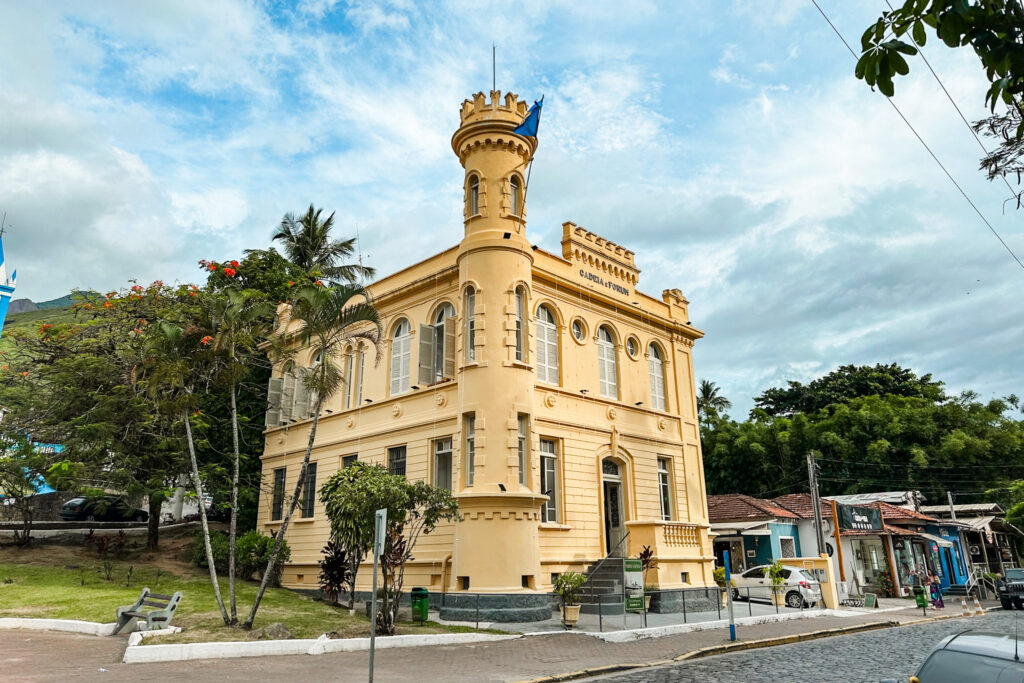
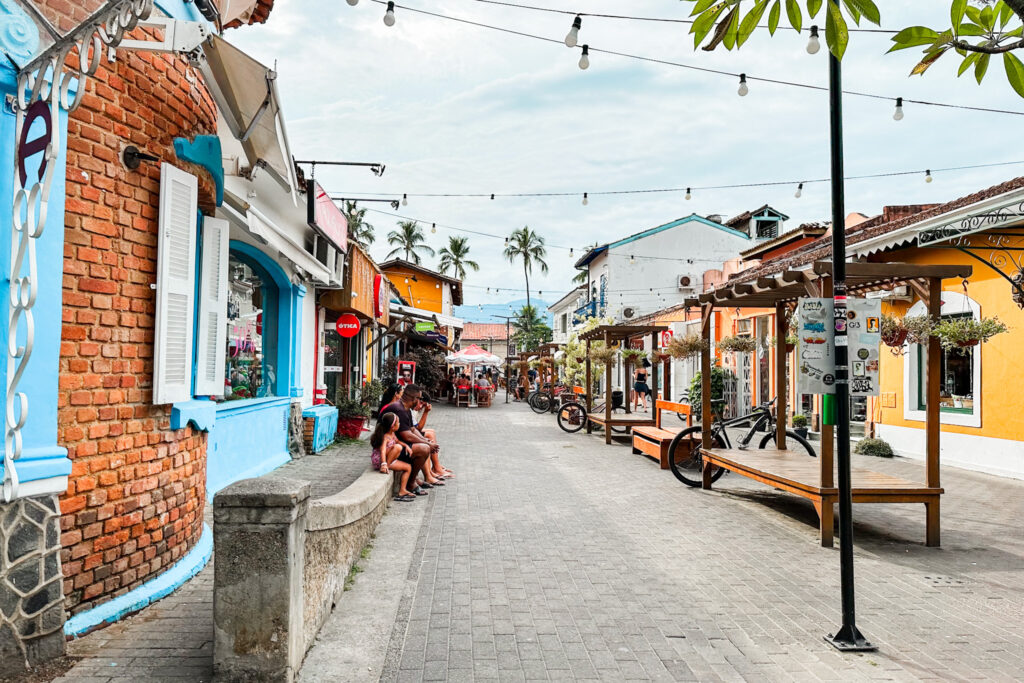
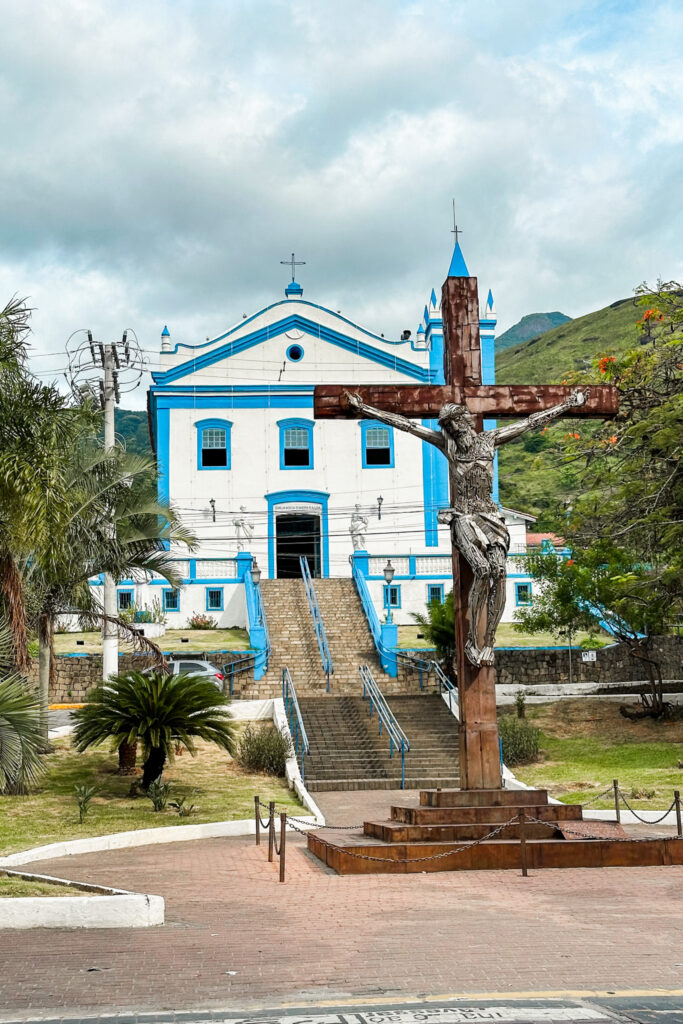
Vila is also an Ilhabela shopping paradise. In the village, you’ll get everything you need to bring back home. We found the souvenirs a little pricy and settled for an Açaí ice cream instead.
Visiting Ilhabela’s old town Vila is perfect for a (half-)day off the beach. You can shop for souvenirs, have a great lunch, get some ice cream, and admire the charming old buildings. Most of Vila’s attractions are free, such as visiting the Igreja de Nossa Senhora or the Ilhabela Nautica Museum. Spend time at the seafront and stroll around the small cobblestone streets of the center.
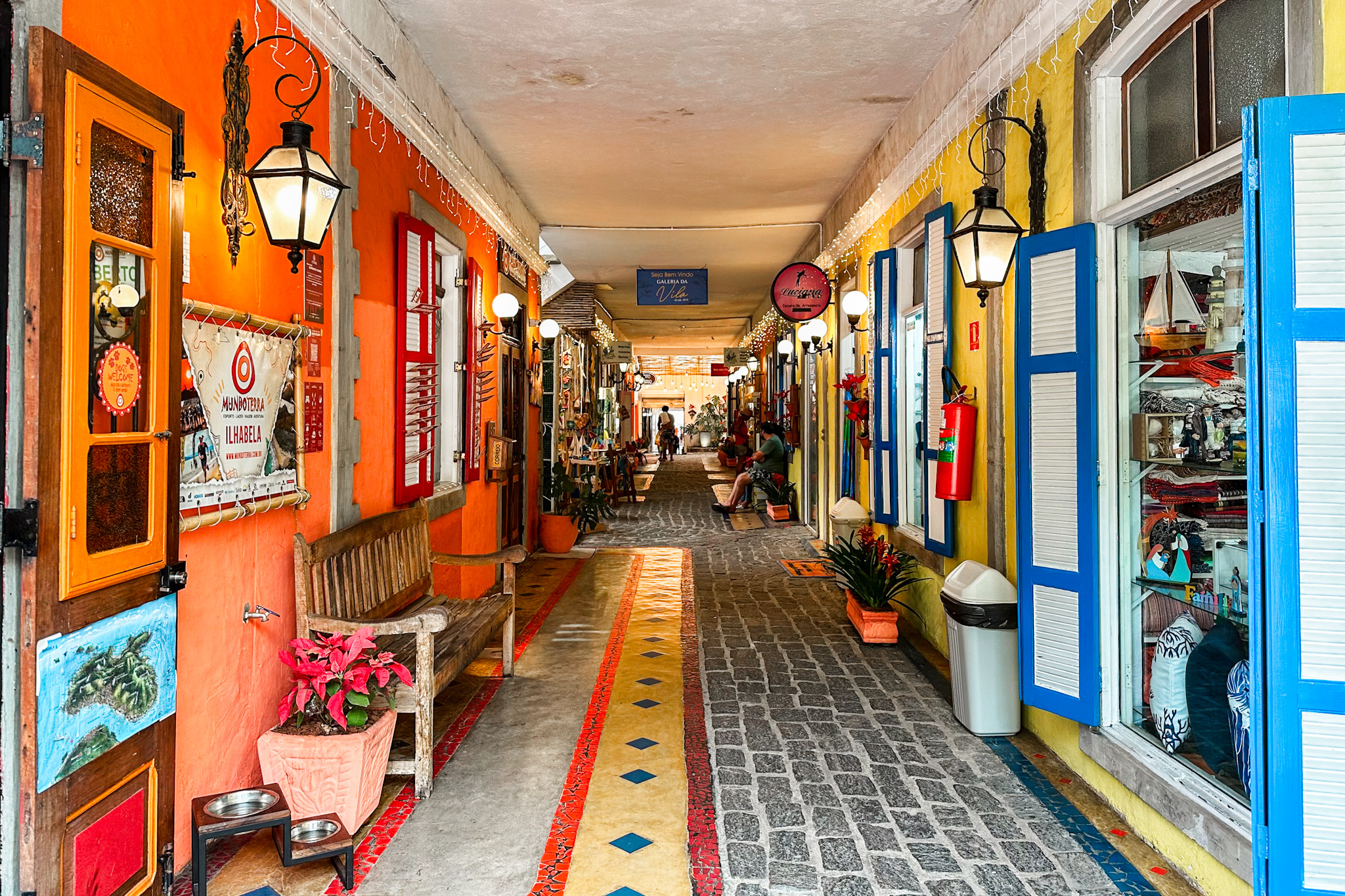
4. Book a tour and go whale watching in Ilhabela
Ilhabela gets a special visitor during the summer that can easily turn your island trip into a one-of-a-lifetime experience. Whales pass by the island between June and September, and you can get to see those incredible marine mammals in the ocean. During this time, local tour companies offer boat trips specifically designed to watch the whales in an ecological, safe, and responsible way. It’s an expensive endeavor but we believe watching humpback whales migrate is a true bucket-list experience.
Sadly, we were in Ilhabela outside the whale season. But the next time we visit the island, we make sure to come for the whales.
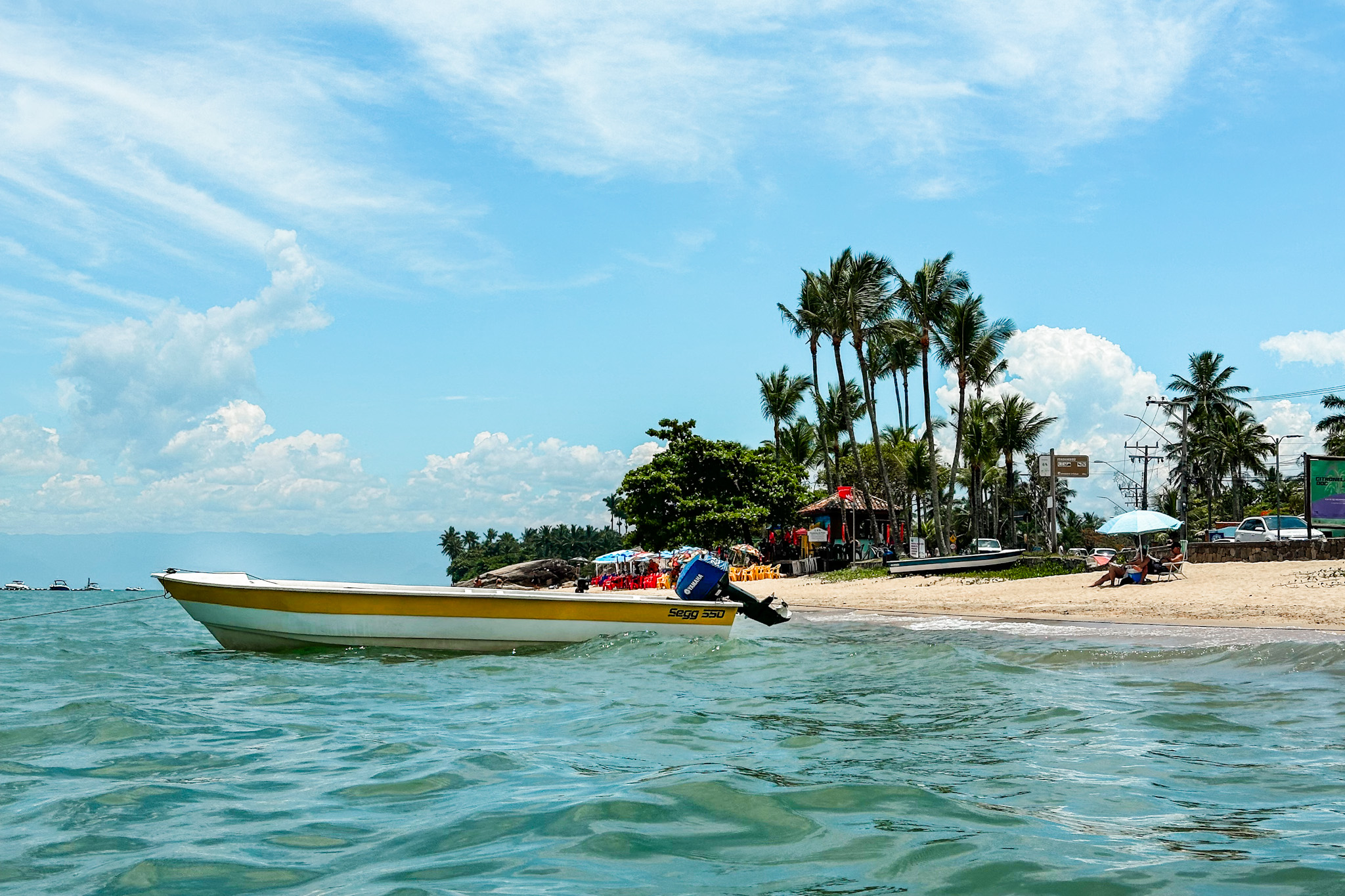
5. Watch the sunset from the Ilhabela viewpoint
Visiting the Ilhabela viewpoint, or Mirante do Piúva Ilhabela is another laid-back thing to do. It’s one of the obligatory postcard picture stops, where you have great views over the maritime channel. Watch sailboats, yachts, and ships pass by, take a photo with the classy Ilhabela sign, and get some coconut water from the nearby kiosk.
The Ilhabela viewpoint is near the port and close to Ilhabela town. It’s convenient to get there by bus, but you’ll also find some free parking spaces near the main coastal road. If there are no cruise ships in town, this place doesn’t get overcrowded. The best time to visit the viewpoint is in the late afternoon, just before sunset. And it is completely free.
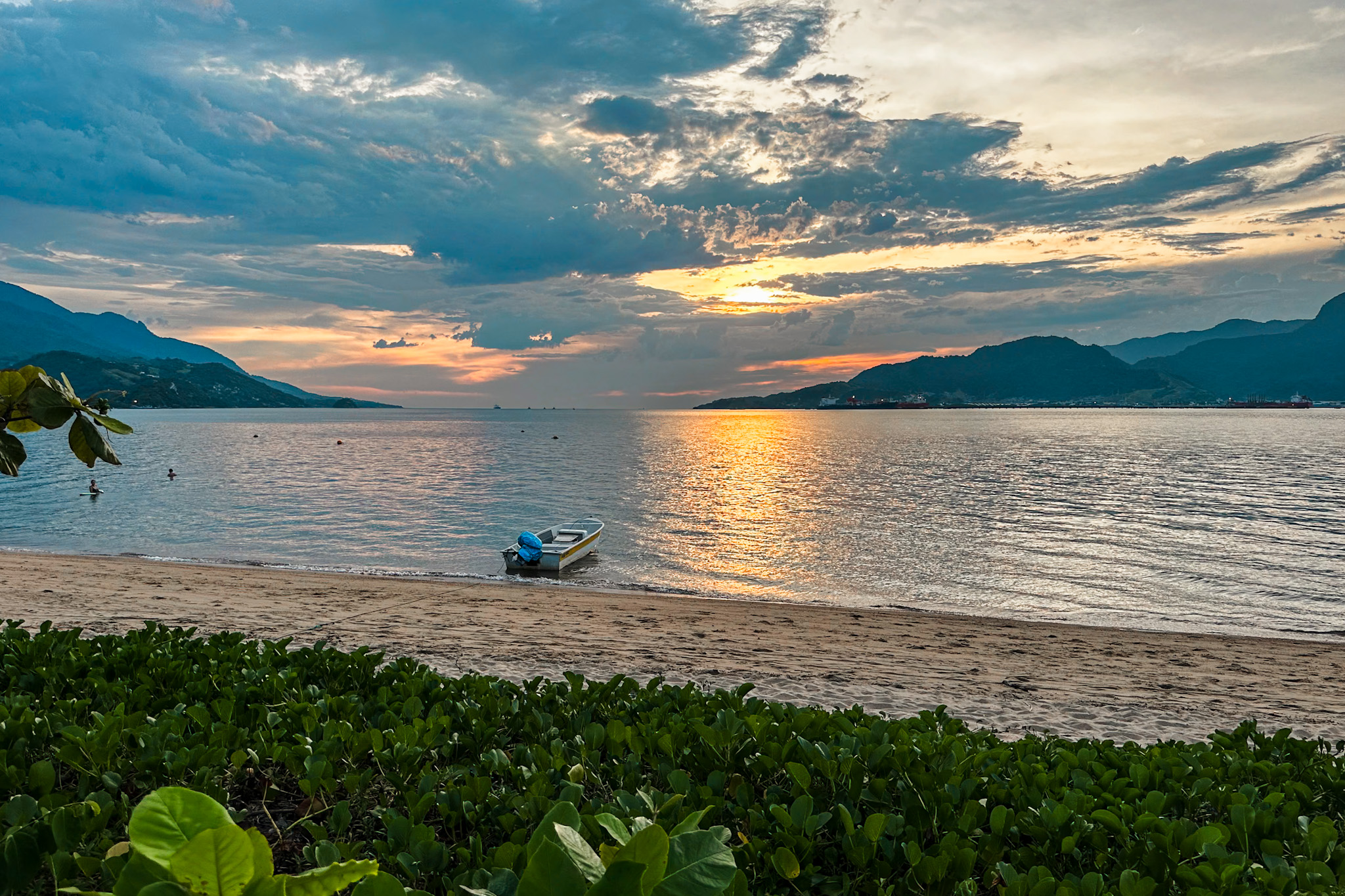
6. Hike Baipi for an unmatched view over Ilhabela
Hiking Baipi is the least laid-back thing to do in Ilhabela and -without question- a tough one to complete. Still, we couldn’t spare it off our list, because those who make it to the top will be rewarded with the best view of the island.
The hiking trail to Baipi is well-marked and starts near the beaches of Praia do Peréque and Itaguaçu. It takes around 1.5 – 2.5 hours up and 1 – 1.5 hours down. If you aren’t a resident, then you must take a guide from the entrance for around 200 BRL (≈ 41 USD) per person, which we found extremely pricey.
Don’t get demotivated by seeing the locals running or biking the mountain up and down. While we aren’t used to the humid and hot climate, choose a pace that lets you enjoy the hike.

7. Go Diving on Ilhabela
What makes Ilhabela a great diving destination is the crystal clear water and an abundance of marine life. Because diving on Ilhabela isn’t the island’s main draw, diving is relaxing and enjoyable. You won’t find overcrowded dive sites here.
On your dives, expect to see plenty of colorful fish, turtles, rays, seahorses, and morays. Ilhabela’s most popular dive sites are around Ilha das Cabras, a small marine protected area close to Ilhabela’s coast. Dives are shallow and ideal for beginners.
Several dive shops are operating in Ilhabela. If you’re an experienced diver, expect to pay around 400 BRL (≈ 81 USD) per dive. Beginners can go on a Discover Scuba Diving (around 500 BRL (≈ 101 USD)) or sign up for a fully-fledged 3-day Open Water course (around 1750 BRL (≈ 355 USD)).
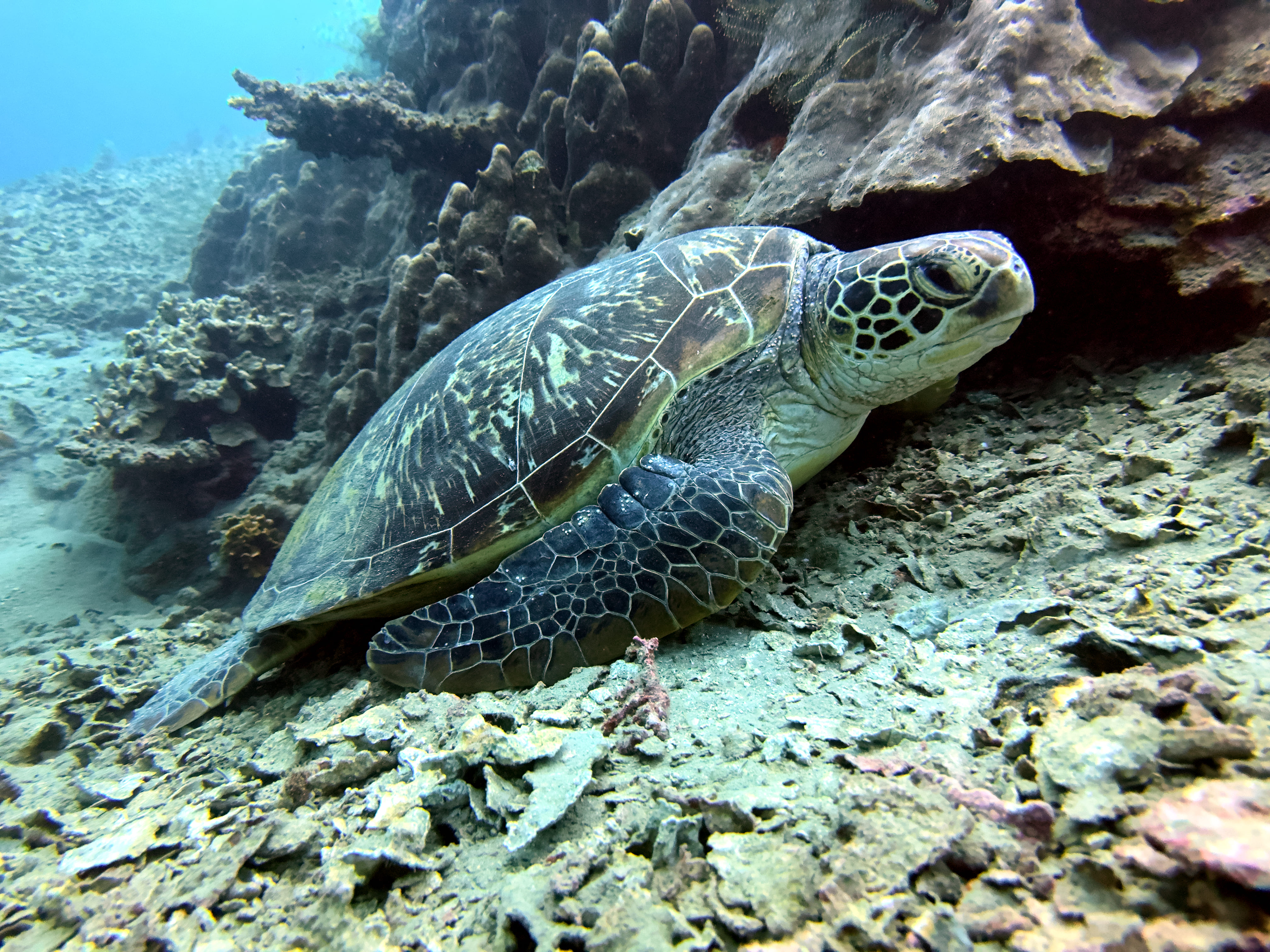
8. Explore the Ilhabela State Park
If you look up Ilhabela on a map, you’ll see that almost all of the island is nature. With over 27,000 hectares, the Ilhabela State Park covers 83% of the island, leaving us with plenty of untouched places to discover. The best way to get deep into nature is by taking an offroad vehicle into the park. Doing so lets you see secluded waterfalls, hidden beaches, and scenic landscapes.
You can explore Ilhabela State Park completely on your own, but chances are that you’d like to jump on an organized Ilhabela jeep tour through the jungle. There are plenty of tour operators in Ilhabela to choose from. Most offer guided day trips into the park at a price point of around 315 BRL (≈ 64 USD). If you want to travel solo, make sure to rent a proper motorcycle or 4×4, bring plenty of water, and access the park early between 7:00 a.m. and 2:00 p.m. (the number of cars that can enter is limited).
Don’t forget mosquito repellent and sunscreen, as the sun and the black flies show no mercy. It’s a must-have, wherever you go in Ilhabela.
9. Join the local festivities in Ilhabela
Island life on Ilhabela doesn’t stand still. Almost every month cool events are happening that you can join. We visited Ilhabela over Christmas and saw the island beautifully decorated in the lights of shooting stars.
Here are the most popular festivities in Ilhabela.
Ilhabela Carnaval (February)
Carnival in Brazil. There really is not much more to say. If you find yourself in Ilhabela during the carnival season, then be prepared for parades and parties. Carnival on Ilhabela marks the peak season of the island. During that time the island changes from a relaxed vacation getaway to a busy paradise with samba music all over the place.
Wedding Season (From March)
In case you find your crush during carnival, the wedding season is waiting for you right around the corner. Jokes aside, from March onwards you can see locals get married on Ilhabela. It’s common, especially for people from Sao Paulo or Rio de Janeiro to say the yes-word on the island.
A Festa Junina (June)
Festas Junia, the June festival, is similar to the European midsummer. During this time a lot of events take place with music, dance, and local food.
Semana International de Velas de Ilhabela (July)
Since 1972 the Ilhabela International Sailing Week (SIVI) has taken place every year. More than 130 sailboats gather at the cost of Ilhabela to compete. It’s an international event, where popular Olympic and Pan American athletes come to Ilhabela to sail, cheer, and celebrate.
During that time, many side events occur outside the Yacht Club of Ilhabela. There are free guided island tours, diving courses, music performances, and various exhibitions that you can visit. It’s a celebration of sports, nature and education.
Festival do Camarão (August)
Festival do Camarão is the so-called Shrimp Festival. It’s a week that is all about food. You’ll find special contests, tastings, fancy menus, and cooking classes. Known national and international chefs visit the island and serve their food creations in various restaurants, stalls, and stores.
Festa de Aniversário de Ilhabela (September)
Festa de Aniversário is one of the most important events in Ilhabela. It marks the island’s birthday. During that time, many events, sports competitions, and shows take place. Famous Brazilian artists visit the island to hold concerts. Celebrate with the locals, if you’re in Ilhabela in September.
Ilhabela in Jazz (October)
It’s no news that music and dance is an essential part of the Brazilian culture. Most of the time you’ll hear and see Brazilian singing and dancing to Samba music, but not in October. Since 2014, the Ilhabela in Jazz Festival has brought jazz vibes to the island. With 20 nights full of concerts, Ilhabela turns into the capital of Jazz, attracting popular artists like Mike Stern and James Carter.
Christmas and New Year (December)
Christmas and New Year are some of the island’s highlights. You’ll see the whole island beautifully decorated, people dressing completely in white (New Year), and hearing Christmas music all over.
For us, spending our Christmas Eve in Ilhabela was so different to home. Don’t expect the island to be covered in snow, but full of lovely people. We spent the day at the beach, enjoying sun, good drinks and joyful vibes. What else can you ask for?

These were only the popular and regular events happening in Ilhabela. If you’d like to see all of the current festivities, you can visit the Ilhabela Bureau of Tourism event page here (Portuguese-only).
How to get to Ilhabela?
To get to Ilhabela you need to get to the town of Sao Sebastiao on the mainland first. Expect long waiting times to get on the ferry to Ilhabela if you arrive by car (not bus/foot). On the website of the island’s tourism board, you can check the current Ilhabela ferry schedule and waiting times before you arrive.
Between 05:30 a.m. and 11:30 p.m., the Ilhabela ferry leaves at both ports every 30 minutes, after that every hour. The ride takes around 20 minutes and is free for all passengers without a vehicle. If you arrive by car or bike, note that ferry prices are different on weekends. Expect to pay 9.50 BRL (≈ 2 USD) / 14.20 BRL (≈ 3 USD) for a bike ticket and 19 BRL (≈ 4 USD) / 28.50 BRL (≈ 6 USD) for a car ticket. Here you can check the current ferry prices for the Ilhabela ferry.
In case you arrive by car or bike, make sure to bring some cash. At the ports, they don’t accept any card payments yet. Also, don’t bother trying to book your ferry ticket online. Be warned: The booking process causes headaches.
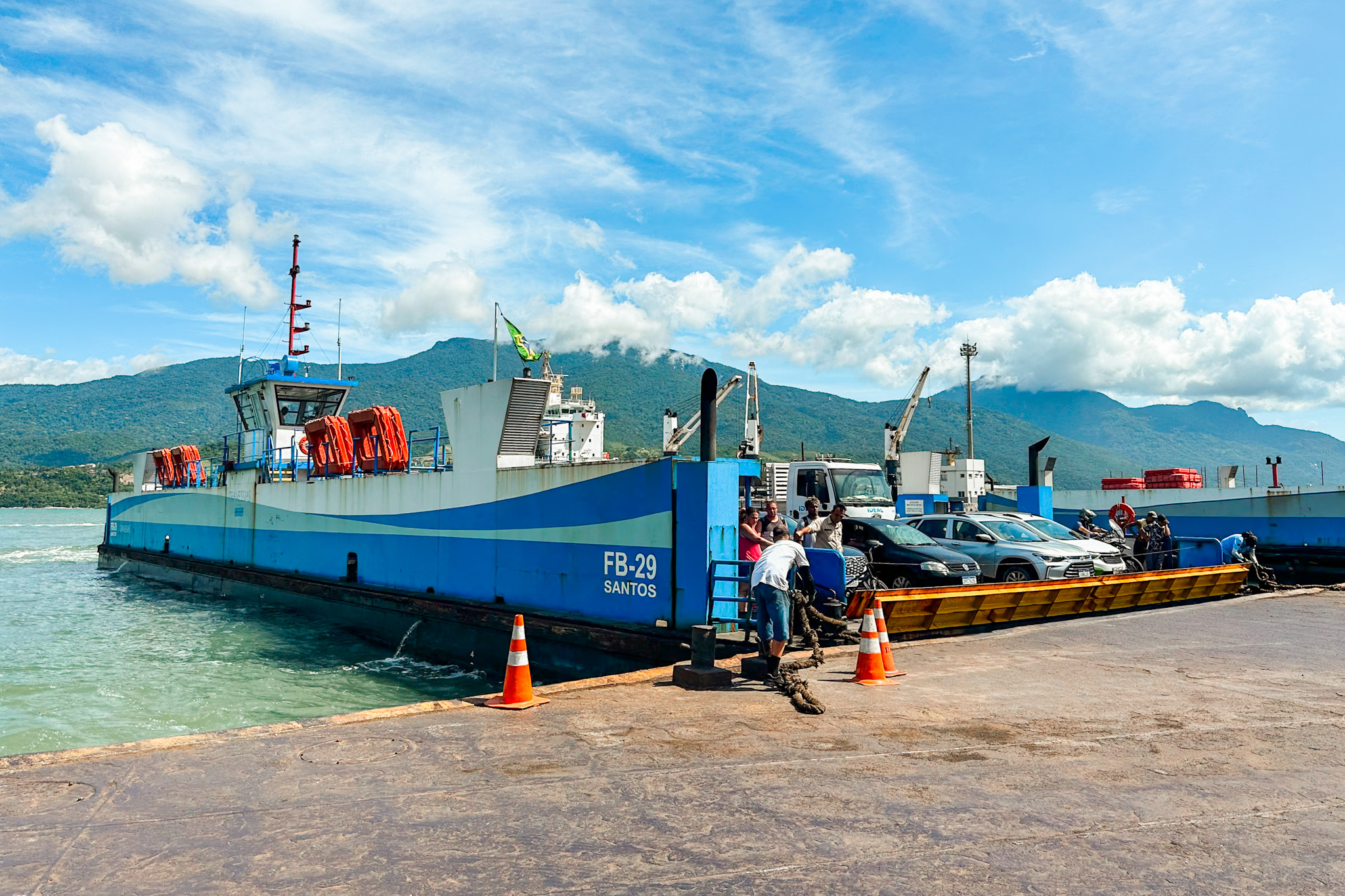
From São Paulo to Ilhabela
If you have your own car, getting from São Paulo to São Sebastião takes around 3-4 hours. The Rio-Santos Highway leads through lush forests, that can get cloudy, so be careful and drive slowly, especially if you’re not used to the traffic in Brazil. Allow another 1-2 hours to get on the ferry, if you decide to travel to Ilhabela on a weekend.
Taking the bus from São Paulo to Ilhabela is very convenient and for most of us foreign travelers surely the best option. Buses leave Sao Paulo several times throughout the day, mostly in the morning. A bus ticket costs between 73 BRL (≈ 15 USD) to 113 BRL (≈ 23 USD) and the bus ride takes around 4 hours. The buses were modern, clean, and well-maintained, so we felt comfortable throughout the trip. Here you can buy your bus ticket from São Paulo to São Sebastião.
From Paraty to Ilhabela
Paraty is a 4-hour drive from São Sebastião, the city from where you take the ferry to Ilhabela. Buses leave Paraty from the Terminal Rodoviário usually in the morning between 9 and 9:30 a.m. Tickets cost around 170 BRL (≈ 34 USD), depending on which bus you choose. You can check the bus schedules and prices here.
Never heard of Paraty? Well, it’s another off-the-beaten-path paradise you surely don’t want to miss if you plan to travel around Brazil. If you’re curious, have a look at our Paraty article on how to get there from Ilhabela.
Relevant Reading
From Rio de Janeiro to Ilhabela
Rio de Janeiro is quite far from Ilhabela. There are several ways how to get from Rio to Ilhabela. While it is possible to take a direct bus from Rio de Janeiro to Sao Sebastiao we wouldn’t recommend you take this almost 8-hour ride.
Make a stop halfway in Paraty and spend one or two nights there to explore Paraty town and the beautiful beaches in Trinidade, before you continue to Ilhabela. Alternatively, book a flight from Rio de Janeiro to Sao Paulo and spend some days there first.
Relevant Reading
Where to stay in Ilhabela?
In Ilhabela, you’ll have a wide variety of accommodation options, ranging from luxurious hotels, over cozy rental apartments to chill hostels. Depending on your travel style, budget, and personal preference, there are plenty of options to choose from.
When locals talk about Ilhabela, they often refer to the North, Center, and South of the island. The North of Ilhabela is around Vila town. This is the place where you’ll find Ilhabela’s historic center, a calm atmosphere, and good infrastructure. The Center of Ilhabela is the place where most residents live. There you’ll find plenty of nice beachfront restaurants and bars. Plus, you can quickly travel to the North or South by bike or bus. The South of Ilhabela is the busiest region. You’ll find lively neighborhoods, nightlife, and a more vibrant (but less relaxed) atmosphere.
When we were choosing our place to stay, it was hard to decide. Not because there were too few, but because they were all pretty amazing. So, we came up with a list of the best places to stay in Ilhabela with a luxury, budget, and value option to match your travel style.
Where to eat in Ilhabela?
Eating out in Ilhabela is such a delight. On the island, there are plenty of restaurants to choose from. Whether you’re looking for a nice beachfront dinner or, a healthy snack, or some cheat-day meals, you’ll find all of them in Ilhabela. It’s hard to pick the best restaurants, that’s why we have three solid recommendations.
Takataka Bar
- Brazilian
- Moderate
A good bar at the beach. They offer delicious snacks, cocktails, and drinks. Combine it with your visit to Praia Grande and Praia do Julião.
Makai Ilhabela
- Brazilian
- Expensive
Popular seafood restaurant in Vila. Serves authentic Brazilian cuisine. Best to visit for sunset for their scenic rooftop. Reservation recommended.
Hamz Artesanal
- Western
- Budget
A nice hamburgeria near Pereque beach. Nothing fancy, but fair prices, good service, and quality food. We went there twice for dinner.

How to get around Ilhabela?
If you ask us for the one island we visited where getting around was easy, then we’ll definitely reply: “Ilhabela”. Over the past 20 years, and especially when Ilhabela became a popular hideout for the Sao Paulo elite, the infrastructure on the island was built out perfectly.
The best way to get around Ilhabela is by biking along the coast. The bike paths are great, and you’ll see the ocean almost all the time. It’s also an inexpensive way to explore the island on your own. You can rent (e-)bikes in a lot of places in Ilhabela.
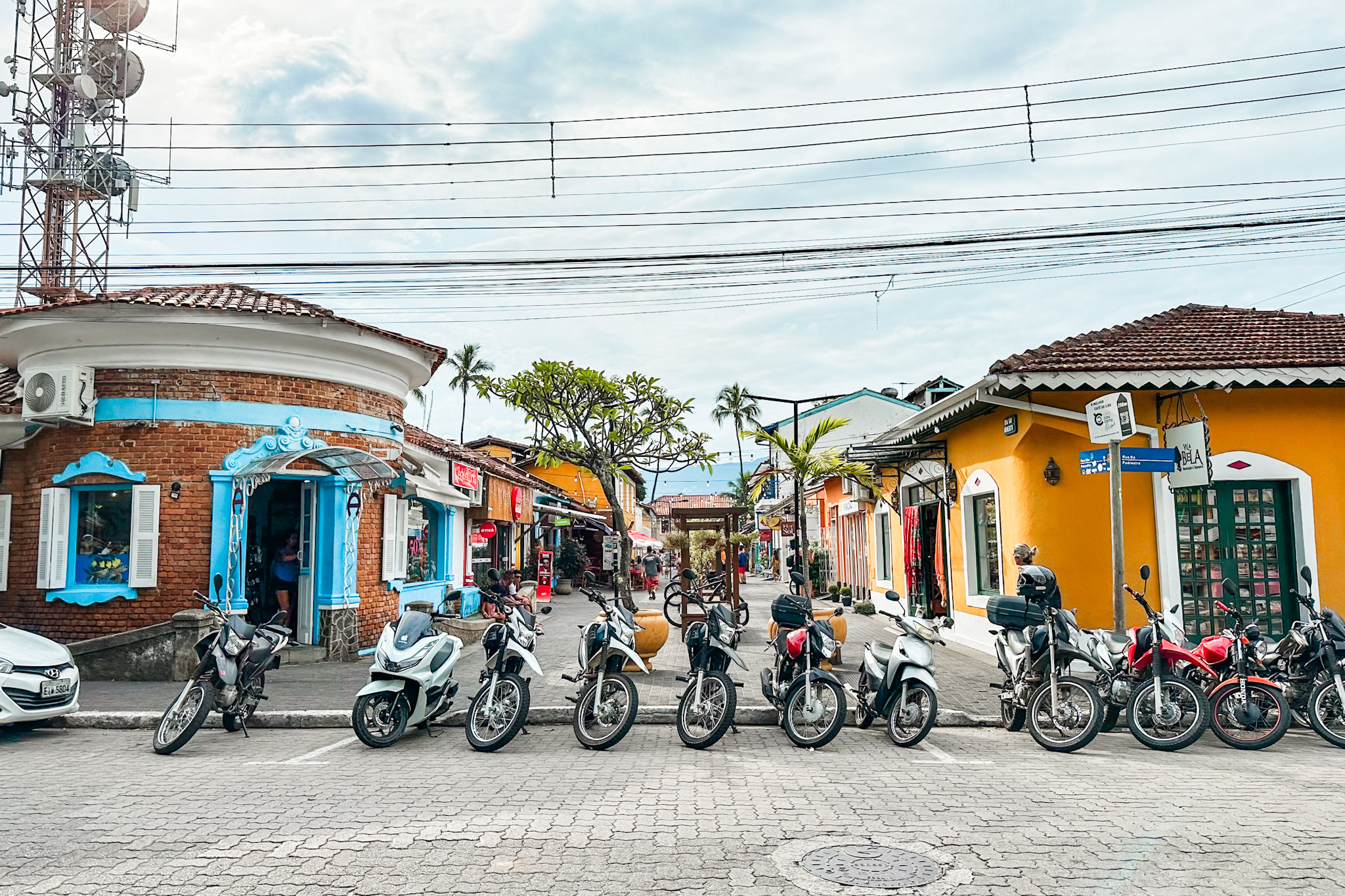
If you aren’t up for biking or want to go a little further, then taking the Ilhabela bus is your next best option. The blue buses on Ilhabela operate mainly along the coast, either driving to the South or North from the main station, near the island’s port.
Because we didn’t know how to ride the bus when we were in Ilhabela, here’s a short introduction: First, you pay a fixed fee of only 4 BRL (≈ 1 USD) upon entering the bus (make sure to bring coins or small bills). The driver hands you a keycard to pass the turnstile. Done. In case you need to go from the north all the way to the south (or the other way around), you have to change buses at the main station, and buy a second ticket.
Don’t count on ride-sharing services like Uber in Ilhabela. When we visited the island, we didn’t find any rides. If you’d like to request a private ride, for example from the port to your accommodation, then take one of the taxis. Taxis are all metered and safe to use.
Lastly, you can rent a scooter instead of always taking a taxi from one place to another. While we have chosen to take the bus, renting a scooter is a good option to explore the island on your own. Plus, you’d be able to access and get around the Ilhabela National Park without a tour.
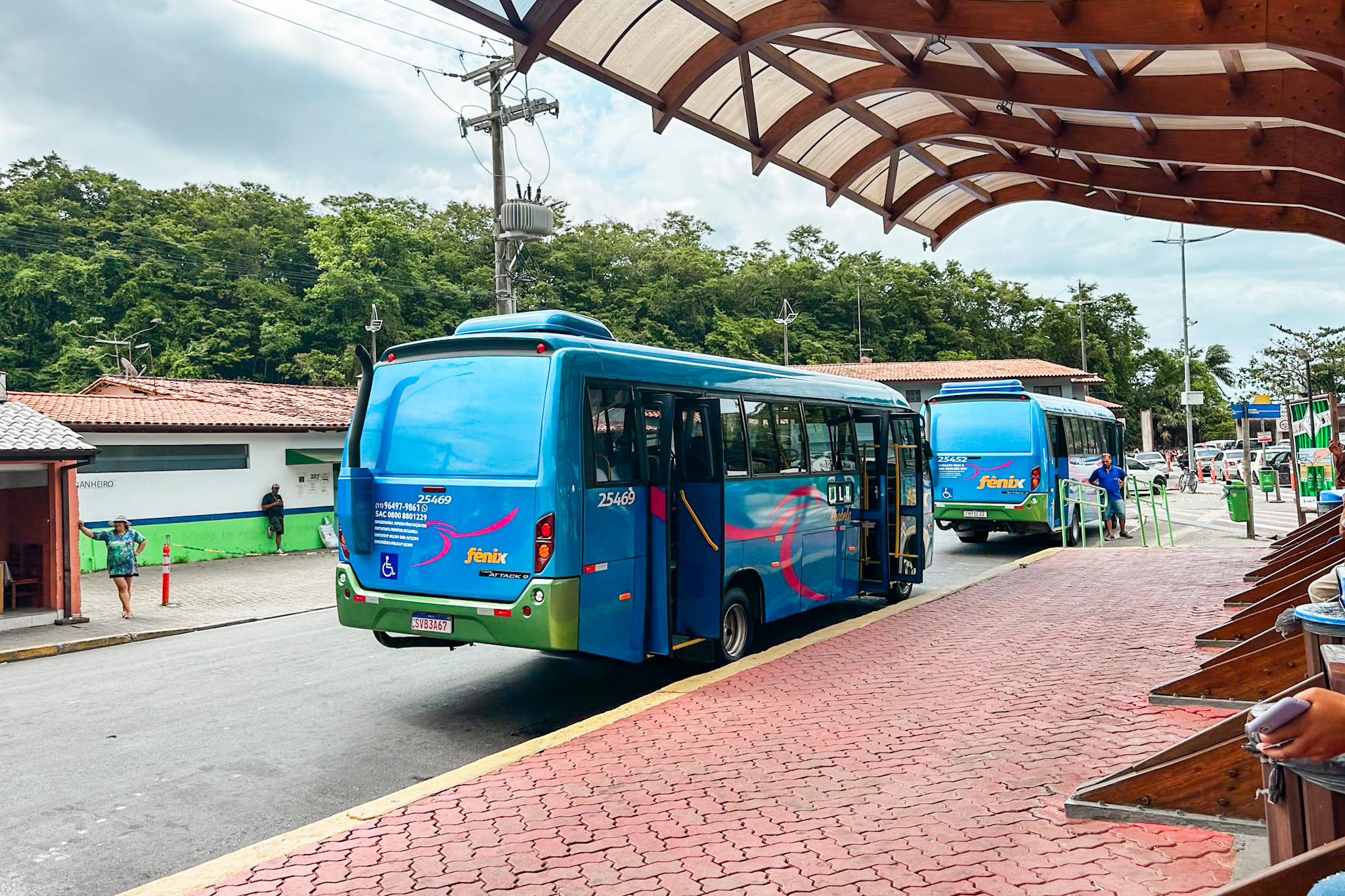
When is the best time to visit Ilhabela?
First things first: The weather in Ilhabela is great all year round. Temperatures never really drop much under 20°C during a cold winter day in June and July and are pleasant between 25 to 30 °C during the Brazilian summer between January and March. However, expec temperatures to feel hotter due to high humidity.
Even though Ilhabela is relatively unknown outside of Brazil, the island can get crowded during the summer. Most of the tourists are Brazilians or from countries nearby that visit Ilhabela in the months from December to March. So, we’d say the best time to visit Ilhabela would be between March and May, when it’s less busy and temperatures still nice – unless you’d like to come here for an event for sure.
We visited Ilhabela over Christmas. The weather was pleasant, with very occasional, short rainfalls. The island was comparably busy, but because of the uncountable number of beaches and waterfalls, it was just the right blend between a castaway paradise and a vibrant island.
Here is our Ilhabela climate graph, so that you can choose the best month to visit the island:
Ever heard of blackflies? We didn’t before we came to Ilhabela. Locals call them “borrachudos” and they can completely ruin all your outdoor trips. Bring plenty of insect repellent and use it generously. Their bites are itchy as hell, and you surely prefer to have nice brown skin rather than having red dots all over your legs. Be warned!
What does it cost to visit Ilhabela?
Visiting Ilhabela will not be a low-budget trip, but if you plan your trip right you can get much value for your money. We spent most of our money on accommodation and food, and comparably little on activities or transportation. So here are a few tips on where to save some bucks without giving up on a great vacation.
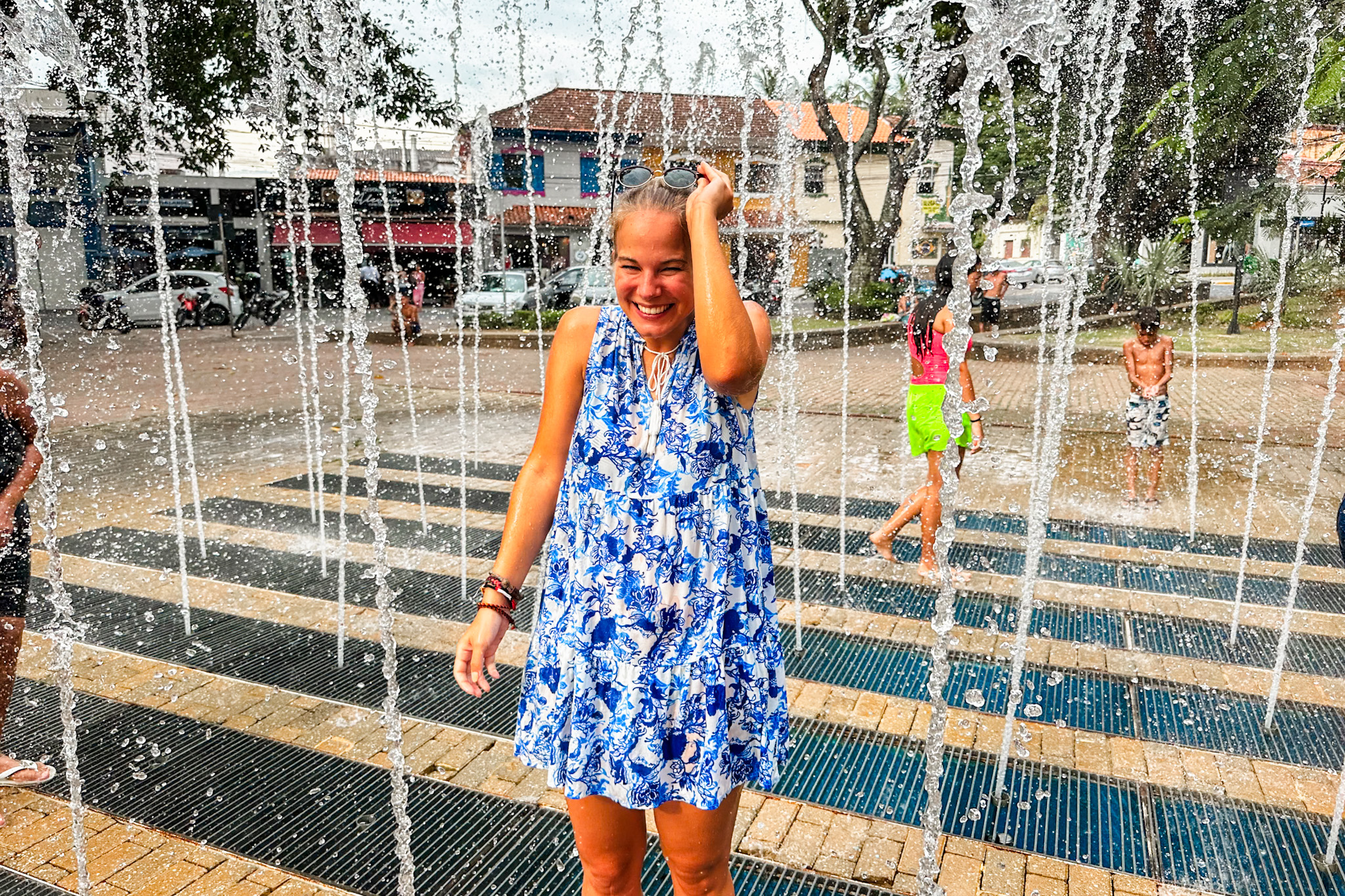
Ilhabela on a budget
We spent a lot of time finding the right place to stay. Even though there were plenty of beautiful accommodations available, we didn’t choose the first one. Chances are, if you keep searching, you’ll find the best value for money. When renting an apartment and cooking for yourself, you can save costs even more. Also, make sure to book your accommodation well in advance for better prices, should you be planning to visit Ilhabela during festival season.
Then, when we arrived in Ilhabela, we took the free ferry to the island and from there the bus to get around the island. We didn’t book expensive activities, such as jet skiing, but always made sure we got a cold beer for sunset. There are plenty to do without spending a penny, like visiting the beaches or hiking to the waterfalls.
Ilhabela cost breakdown
If we recap how much money we spent in Ilhabela, it averages to around 600 BRL (≈ 122 USD). While that gives you a rough estimation for a backpacker couple in Ilhabela, your budget depends on your travel style. That’s why in the following we listed a cost breakdown for your Ilhabela trip.
How many days to stay in Ilhabela?
With over 40 beaches, 360 waterfalls, plenty of events happening, and generally good weather, there’s always something to see and do in Ilhabela. That’s also why many Brazilians have built their vacation homes on Ilhabela. It’s hard to find a reason to leave.
But as tourists, we’d say that the sweet spot is somewhere between three days to two weeks. We spent a little over a week in Ilhabela and never got bored. Whenever we felt like exploring the island we found plenty of interesting places to go.
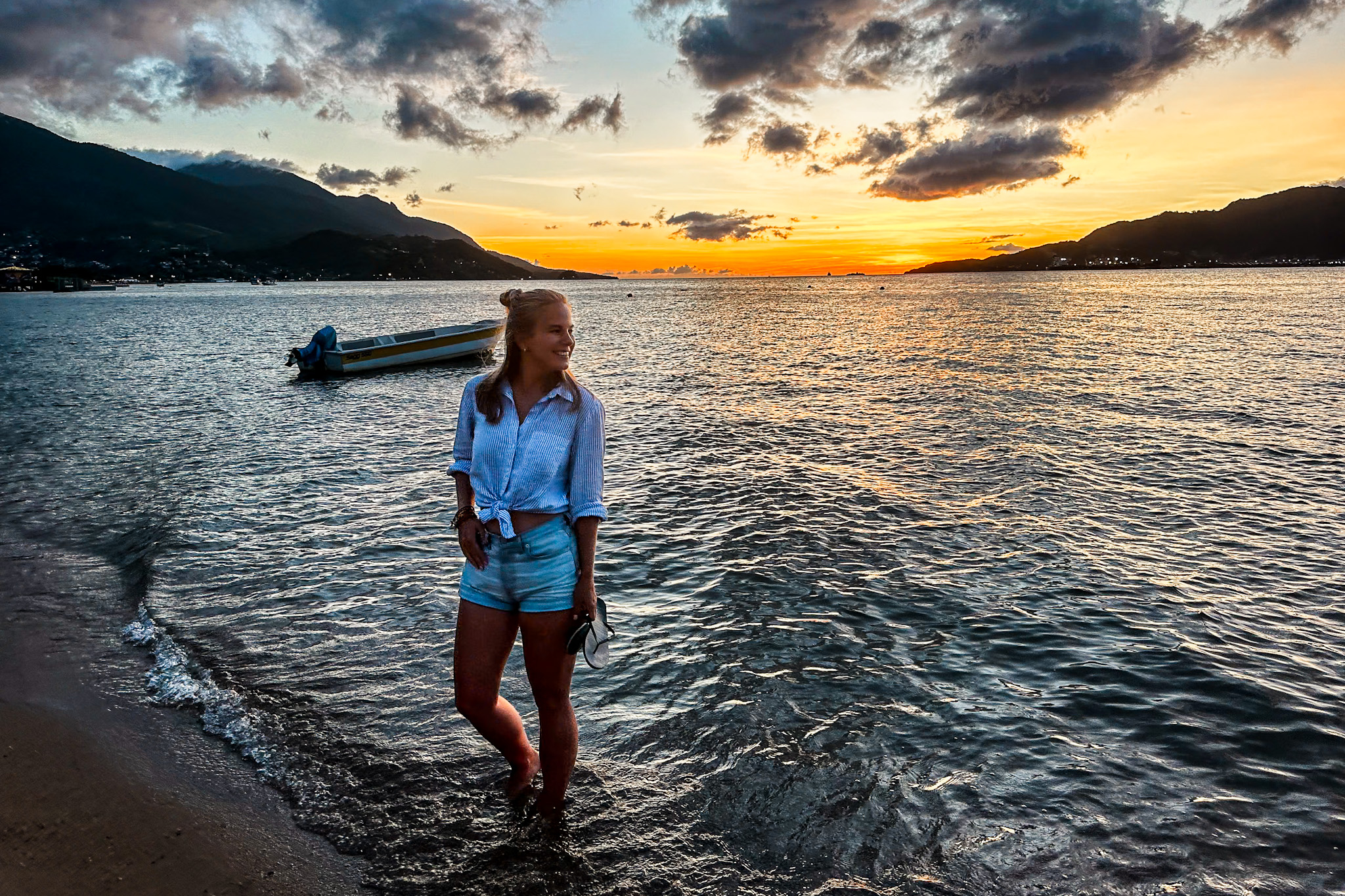
Our Experience in Ilhabela
We had planned to spend Christmas on the island, far away from the hustle and bustle. A little tired from the 4-hour bus ride, we checked in to our lovely airbnb apartment, bought some ice-cold beers, and headed to the beach. We dipped in the crystal-clear water of the ocean, walked along the sandy beach, and watched an amazing sunset. We had finally arrived in paradise.
The next days, we swam with turtles, did some hikes, explored amazing waterfalls, and tasted the best caipirinhas we ever had. One thing we noticed when we were visiting Ilhabela is, that it’s a popular travel destination among locals. We’ve met many Brazilians, mainly from Sao Paulo, but only very few foreigners. For us, it was just perfectly authentic. We felt like we’d found kind of an undiscovered paradise. We loved the laid-back lifestyle on Ilhabela. People are different here. Super friendly, always helpful, and not used to Western tourists at all.
